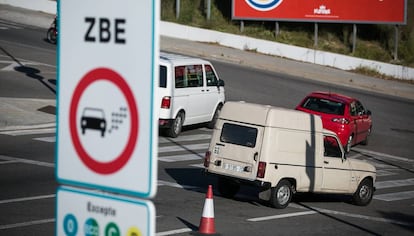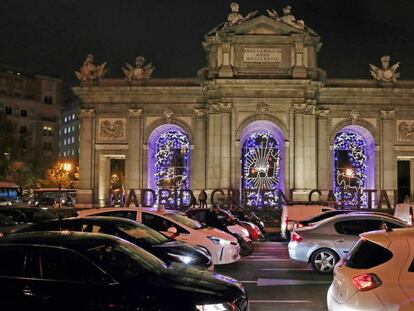Barcelona debuts low-emissions area, but will public transport be able to cope?
The new zone covers 95 square kilometers and will affect around 85,000 cars and 30,000 motorbikes, with older, more contaminating vehicles facing fines for infractions


After three years of announcements, technical work and administrative and political procedures, Thursday will see the city of Barcelona put into action its Low Emissions Zone (ZBE), an area measuring 95 square kilometers that the most-contaminating vehicles will not be able to enter. The initiative will affect 85,000 cars and 30,000 motorbikes, and is likely to see a surge in the use of public transportation. According to the Metropolitan Transit Authority (ATM) in the Catalan capital, there will be a total of 170,000 extra journeys on buses and trains, a spike in demand that will be complicated by the lack of extra services on the local networks.
There could be as many as 170,000 extra journeys on buses and trains
The ATM claims that improvements made over recent years have prepared public transportation for these new passengers. These include new express bus lines, stations on lines 9 and 10 of the Metro system, and extensions to one of the busiest train lines. But the majority of the improvements announced in recent years are yet to be implemented. New bus lanes are yet to arrive, and “park and ride” systems are still not in place. With overcrowding during rush hour on many train lines also a serious issue, the RACC automobile club said several weeks ago that the extra demand that the traffic restrictions will cause cannot be absorbed.
Even the city councilor for climate emergency, Eloi Badia, admitted before Christmas in an interview with EL PAÍS that, while the capital has a solid network of Metro trains and buses, the “challenge is intercity transportation.” Badia called on the regional government and the Spanish government to do their part to improve these links.
Meanwhile, dozens of signs have been put in place to inform motorists of the new system in Barcelona, along with the latest technology for detecting and recording license plates. The ZBE will cover Barcelona, L’Hospitalet de Llobregat, Sant Adrià del Besòs and parts of Esplugues and Cornellà de Llobregat.
Dozens of signs have been put in place to inform motorists of the new system in Barcelona
The veto on older, more-contaminating cars – those that do not qualify for the environmental badge issued by Spain’s DGT traffic authority – will be in place on working days from 7am to 8pm, and for the first year will just apply to cars and motorbikes. During the first three months of the scheme there will be no fines, just warnings for violators. In 2021, any vans, trucks and buses without the environmental badge will also be prohibited from entering the area.
The real impact of the ZBE will not be noted until next week, given that many families are still enjoying their Christmas vacations, Monday is a national holiday for Kings’ Day and schools will not reopen until January 8.
The scheme follows in the footsteps of Madrid Central, a low-emissions zone that was put into place in the Spanish capital in November 2018 by then-Mayor Manuela Carmena. The system made 472 hectares of the city center off-limits to traffic, apart from local residents and public transportation. Non-residents with appropriate energy labels may enter to leave their vehicle in a public parking lot, and exceptions are made for people with reduced mobility, ambulances, taxis, private-hire cars and delivery vans. Electric vehicles are also allowed into Madrid Central.
English version by Simon Hunter.
Tu suscripción se está usando en otro dispositivo
¿Quieres añadir otro usuario a tu suscripción?
Si continúas leyendo en este dispositivo, no se podrá leer en el otro.
FlechaTu suscripción se está usando en otro dispositivo y solo puedes acceder a EL PAÍS desde un dispositivo a la vez.
Si quieres compartir tu cuenta, cambia tu suscripción a la modalidad Premium, así podrás añadir otro usuario. Cada uno accederá con su propia cuenta de email, lo que os permitirá personalizar vuestra experiencia en EL PAÍS.
¿Tienes una suscripción de empresa? Accede aquí para contratar más cuentas.
En el caso de no saber quién está usando tu cuenta, te recomendamos cambiar tu contraseña aquí.
Si decides continuar compartiendo tu cuenta, este mensaje se mostrará en tu dispositivo y en el de la otra persona que está usando tu cuenta de forma indefinida, afectando a tu experiencia de lectura. Puedes consultar aquí los términos y condiciones de la suscripción digital.
More information
Archived In
Últimas noticias
Rowan Atkinson tops Netflix at 70: ‘He’s as funny as ever’
Israeli recognition of Somaliland stirs up the Gulf
Tiger Woods turns 50: Will he continue playing on the PGA Tour or take a back seat?
The surreal journey of James Nnaji, the Barcelona youth player selected in the NBA Draft who ended up in the NCAA
Most viewed
- Oona Chaplin: ‘I told James Cameron that I was living in a treehouse and starting a permaculture project with a friend’
- Reinhard Genzel, Nobel laureate in physics: ‘One-minute videos will never give you the truth’
- Sinaloa Cartel war is taking its toll on Los Chapitos
- Why the price of coffee has skyrocketed: from Brazilian plantations to specialty coffee houses
- Chevy Chase, the beloved comedian who was a monster off camera: ‘Not everyone hated him, just the people who’ve worked with him’










































